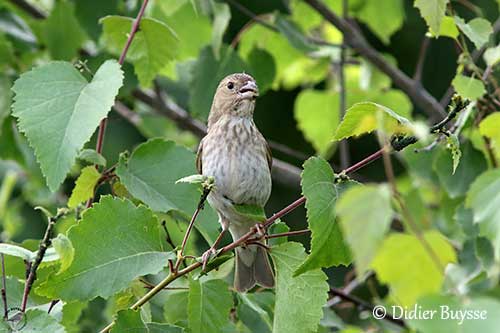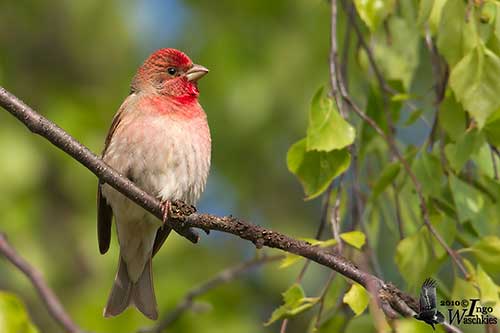
Fr: Roselin cramoisi
Ang: Common Rosefinch
All: Karmingimpel
Esp: Camachuelo Carminoso
Ita: Ciuffolotto scarlatto
Nd: Roodmus
Sd: rosenfink
Photographers:
John Anderson
John Anderson Photo Galleries
Didier Buysse
Vision d’Oiseaux
Ken Havard
My Bird Gallery & Flickr gallery 1 & Flickr gallery 2
Ingo Waschkies
Bird Photography
Text by Nicole Bouglouan
Sources:
HANDBOOK OF THE BIRDS OF THE WORLD Vol 15 by Josep del Hoyo-Andrew Elliot-David Christie - Lynx Edicions – ISBN: 9788496553682
Ottaviani, M. (2008) Monographie des Fringilles (fringillinés – carduélinés) – Histoire Naturelle et photographies, Volume 1. Editions Prin, Ingré, France, 488 p
THE HANDBOOK OF BIRD IDENTIFICATION FOR EUROPE AND THE WESTERN PALEARCTIC by Mark Beaman, Steve Madge - C. Helm - ISBN: 0713639601
FINCHES AND SPARROWS by Peter Clement, Alan Harris and John Davis – Helm Identification Guides – ISBN: 0713652039
What Bird-The ultimate Bird Guide (Mitchell Waite)
Wikipedia, the free encyclopaedia
South Dakota Birds and Birding – (Terry L. Sohl)
Common Rosefinch
Carpodacus erythrynus
Passeriformes Order – Fringillidae Family
INTRODUCTION:
The Common Rosefinch is a small, stocky Fringillidae usually common and widespread in Asia and Europe, breeding in the northern parts of the range and wintering southwards.
It frequents woodlands, thickets and forest edges near water in summer. During winter, it is mainly found in gardens and orchards, and also in damp and bushy meadows. This species nests in a loose, cup-shaped structure placed fairly low in vegetation or tree.
The Common Rosefinch is not globally threatened, but the population trend is suspected to be decreasing slowly. However, it is still common for now.
DESCRIPTION OF THE BIRD:
Biometrics:
Length: 13-15 cm
Weight: 19-33 g
The Common Rosefinch adult male in breeding plumage has brown to dusky brown mantle, back, lesser coverts and scapulars, with paler edges to feathers. All are tinged red except in worn plumage.
The rump varies from pinkish-red to deep red, but it depends on the bird’s age, with some individuals showing brown-tipped feathers. The uppertail-coverts are brown with red tinge. The notched tail is brown with broad, paler to reddish-brown edges to outer rectrices.
On the upperwing, median and greater coverts are dark brown with paler edges and pale pink tips, forming a double wingbar. Alula, primary coverts and flight-feathers are dark brown with pale edges. Primaries and secondaries are tinged pale reddish-buff towards the tip.

On the underparts, chin, throat and breast centre are variably crimson. Breast sides and belly are buffish-white, sometimes slightly washed crimson. The flanks are tinged buffish-brown or sometimes washed with red. Undertail-coverts and thighs are whitish to buffish-white.
On the head, forehead to crown, nape and hindneck are bright red, often variable in extent and with brown bases to feathers. The lores are ashy-brown. Cheeks and ear-coverts are more or less dark brown, with variable crimson wash.
The fairly stout bill is greyish to dark grey-brown, but some adults may show pale yellowish-brown or pinkish base of lower mandible. The eyes are dark brown. Legs and feet are brown to pinkish-brown.
The adult male in winter has much duller plumage, including on the head.
The adult female is duller, with dull grey-brown plumage. Both upperparts and underparts are slightly dark-streaked. There are two weak pale wingbars.
On the plain, pale olive-brown head, forehead and crown show fine blackish streaks. The face is slightly paler. We can see a short, whitish-buff supercilium and a sub-ocular crescent. A broad, pale buff moustachial stripe is bordered by a darker malar stripe. The bare parts are similar to male.
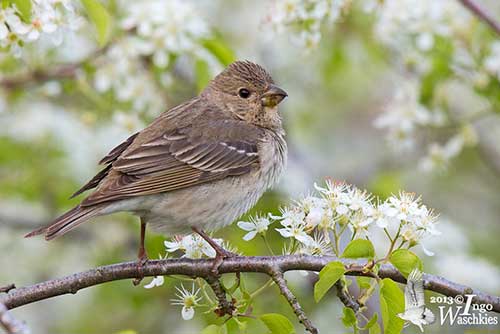
The juvenile resembles adult female, but with brighter plumage overall. The wingbars are more conspicuous, like the pale tips to tertials, and the streaking is heavier.
The full adult plumage of males is not complete until the autumn or even later.
Both first summer and second summer males are like the adult female.
SUBSPECIES AND RANGE:
The Common Rosefinch has five subspecies that differ mainly in intensity and extend of red on head, upperparts and underparts, but in non-breeding plumage, these differences are less conspicuous.
C.e. erythrinus (described above) is found in N, C and E Europe, W and C Siberia and NW Mongolia, and in S from NW Balkans, Romania and N Ukraine, E to N Kazakhstan. It winters in N India, lowland Nepal, Bhutan, N Myanmar and NW Thailand.
C.e. ferghanensis occurs in E and SE Kazakhstan and W China, S to Afghanistan, W Pakistan and NW Himalayas. It winters to NW India.
This race has darker brown head and upperparts, and less reddish on the upperparts. On the underparts, belly and flanks show larger extent of rose-red.
The female is darker or browner.
C.e. roseatus is found in C and E Himalayas, E to NE India and E to C and S China. It winters in India E to Myanmar, Thailand, Laos, Vietnam and S and SE China.
In this race, the breeding male is deeper red than other races, with deep carmine on head and upperparts, bright carmine-red rump, whereas mantle and scapulars are streaked blackish. On the underparts, the red extends down to the breast and slightly onto belly and flanks.
The female is darker brown with heavier streaking overall.
C.e. grebnitskii is found in E Siberia and Russian Far East, N Mongolia, NE China and N Sakhalin. It winters in SE and S China, S to N Thailand and N Vietnam.
This race is darker carmine-red than nominate, with deeper red upperparts, and paler or more pinkish-red underparts extending to belly and flanks.
The female is darker or browner overall.
C.e. kubanensis occurs in N and E Turkey, Caucasus and N and NE Iran. It winters to N India.
In this race, the male is similar to nominate, with deeper red head and breast. Mantle and scapulars are brown with reddish tinge. On the underparts, pinkish-red extends to upper belly and flanks.
The female is paler and greyer, less olive-tinged than nominate.
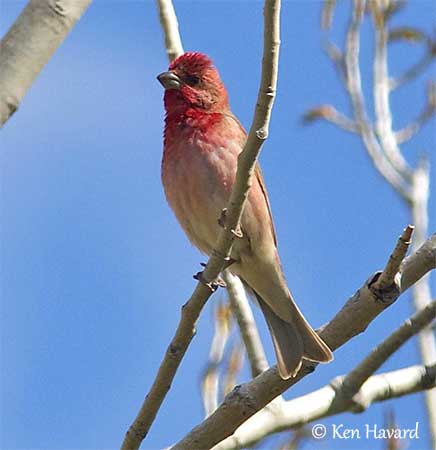
HABITAT:
The Common Rosefinch breeds in deciduous scrubby and dense bushy areas, on lakeshores, in parks and smaller thickets, along streams and field edges, and also in bushy clearings and deciduous woodlands, from 200 up to 3,600 metres of elevation depending on the range.
During winter, it usually occurs at lower levels, often below 1,500/2,000 metres. It frequents similar habitats in foothills, lowlands, reedbeds and edges of cultivated fields. On passage, it also frequents coastal woodlands and scrub.
CALLS AND SONGS: SOUNDS BY XENO-CANTO
The Common Rosefinch’s usual call is a clear, sweet “ueet” sometimes slightly harsher, similar to the call of the European Greenfinch. The alarm call is described as “djuwee”.
The song is a soft whistling, a clear fluty phrase of 3-4 notes, rather plaintive, rising and falling in pitch, with some variation between individuals “ste-too-weet-tew”.
During the courtship, the male gives quiet chattering and twittering notes interspersed with loud phrases of the song.
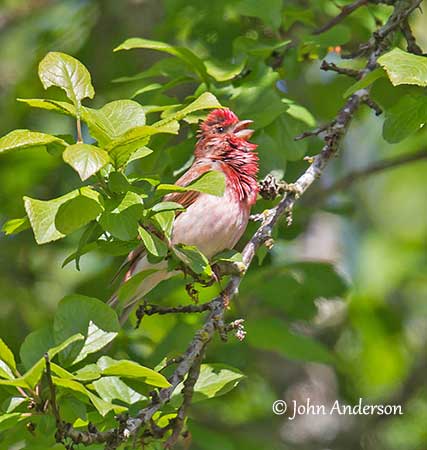
BEHAVIOUR IN THE WILD:
The Common Rosefinch feeds mainly on seeds, shoots and buds, and also takes fruit, berries and nectar. It consumes some insects and larvae, and various other arthropods, especially during the breeding season in summer.
It forages on the ground among the low vegetation, in grasses and bushes. But it also forages at all levels in trees where it finds buds and fruits.
It can be seen alone, in pairs or in small groups. But after breeding, it forms large flocks including several family groups. Larger flocks of 100/200 individuals are common outside breeding season, and it also joins mixed-species flocks.
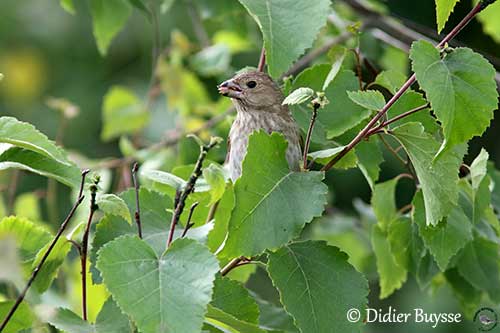
The Common Rosefinch is usually monogamous with pair-bonds lasting a single season, occasionally more. The territory is defended by both adults, but mainly by the male.
The male arrives first at the breeding areas. At the beginning of the breeding season, it sings from regular perches to attract a female. During the displays, both adults are close together on the ground, on rock or branch. The male has the head held high with raised crown feathers, while the wings are drooped and quivering, and the tail partly raised.
It slowly circles the female, or the birds also take turns to circle each other, always with head-up posture. The male also swings its body from side to side with vibrating wings, or bows towards the female before to throw the head back while singing.
Other displays include a slow butterfly-like flight on stiff wings by the male, courtship feeding and mate-guarding when the female is feeding.
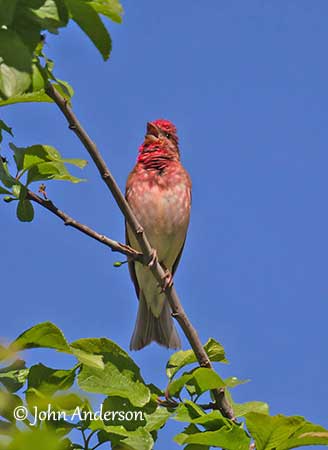
The Common Rosefinch is migratory. It moves at night, but it is also diurnal during the spring passage. It moves in small flocks but also up to 200 individuals, and even flocks of several hundred birds.
All races migrate southwards after the breeding season. They leave the breeding sites in late July/early August, and they return from mid-April to late May.
The flight is bounding with rapid wingbeats interspersed with brief periods of wings drawn to the body sides.
REPRODUCTION OF THIS SPECIES:
The breeding season takes place between May and August. This species only produces a single brood per season.
The female builds the nest, a loose, cup-shaped structure made with twigs, stems, fibres, grass, plant down, moss, lichens and animal hair. It is lined inside with softer materials.
The nest is placed 1-2 metres from the ground, occasionally up to ten metres in bush, in juniper, spruce or willow sapling. It is often hidden among the foliage or against the trunk.
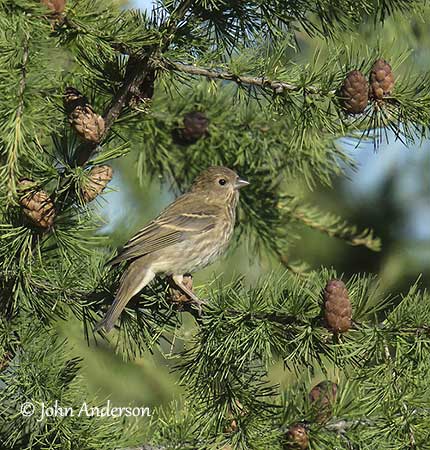
The female lays 4-6 pale bluish-green eggs with darker markings. She incubates alone during 11-14 days, sometimes fed by the male. The chicks are fed by both parents. They leave the nest 10-13 days after hatching, but they are not able to fly. They depend on adults for food for two weeks.
The Common Rosefinch breeds solitary or in loose colonies.
PROTECTION / THREATS / STATUS:
The Common Rosefinch is described as common to locally common.
The global population is estimated to number 62,400,000/113,200,000 mature individuals, but more information is needed. The population trend in Europe was decreasing from 1980 to 2013.
Any current significant threats are known in Europe, and the species is not considered globally threatened.
The Common Rosefinch is currently evaluated as Least Concern.
